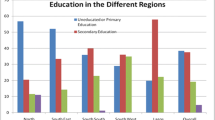Abstract
This paper utilises the framework of a Polytomous Logit Model for analysing and testing the economic behaviour of worker migrants between different regions (states) in India. The model is estimated, perhaps for the first time in India, with policy and non-policy economic variables, using 1971 Population (migration) Census data. The empirical results with regard to policy variables provide new evidence that federal transfers have resource (labour) allocation effects rather than pure income redistribution effects and that workers move from high tax regions to low tax regions. The results support the familiar Tiebout hypothesis and argue for an inter-regional migration policy for India as well as for other developing countries.
Similar content being viewed by others
References
Bahl, R.W. and P. Velayudhan (1976). ‘The Allocative Efficiency Effects of Inter-governmental Flows in Less-developed Countries: A Case Study of India’, Public Finance 31: 73–89.
Bewley, T.F. (1981). ‘A Critique of Tiebout Theory of Local Public Expenditure’, Econometrica 49: 713–740.
Cebula, R.J. (1980). ‘Voting with one's feet: A critique of the evidence’, Regional Science and Urban Economics 10: 91–107.
Cebula, R.J. (1978). ‘An Empirical Note on the Tiebout-Tullock Hypothesis’, Quarterly Journal of Economics XCII: 705–711.
Cebula, R.J. (1974). ‘Inter-state Migration and the Tiebout Hypothesis: An analysis according to race, sex and age’, Journal of American Statistical Association 69: 876–879.
Census of India (1971). Migration Tables (1971), Part II-D (ii), Series I. New Delhi: Office of the Registrar-General and Census Commissioner (1977).
Census of India (1981). Report and Tables based on a 5 per cent sample data, Series I (India), Part-II (Special). New Delhi: Office of the Registrar-General and Census Commissioner.
Fields, G.S. (1982). ‘Place-to-place Migration in Columbia’, Economic Development and Cultural Change 30: 539–558.
Government of India (1983). Regional Development of India's Economic Development. New Delhi: Planning Commission.
Government of Karnataka (1977). Statistical Abstract of Karnataka. Bangalore (India): Bureau of Economics and Statistics.
Greenwood, M.J. (1985). ‘Human Migration: Theory, Models and Empirical Studies’, Journal of Regional Science 25: 521–544.
Greenwood, M.J. (1975). ‘Simultaneity Bias in Migration Models: An Empirical Examination’, Demography 12: 519–536.
Greenwood, M.J. (1971a). ‘An Analysis of the Determinants of Internal Labour Mobility in India’, Annals of Regional Science 5: 137–151.
Greenwood, M.J. (1971b). ‘A Regression Analysis of Migration to Urban Areas of a Less-developed Country: The Case of India’, Journal of Regional Science 11: 253–262.
Greenwood, M.J. (1969). ‘The determinants of labour migration in Egypt’, Journal of Regional Science 9: 283–290.
Hensher, D.A. and L.W. Johnson (1981). Applied Discrete-choice Modelling. 1st ed. New York: John Wiley.
Maddala, G.S. (1983). Limited-dependent and Qualitative Variables in Econometrics. 1st ed. Cambridge: Cambridge University Press.
Majumdar, D. (1987). ‘Rural-urban Migration in Developing countries’, in Edwin S. Mills (ed.), Handbook on Regional and Urban Economics, Vol. II. Amsterdam: North-Holland.
McCarthy, M.R. and T.G. McCarthy (1989). ‘Irish Migration: The Search for the Efficiency and Equity basis of a European Regional Policy’, The Economic and Social Review 21: 71–84.
McFadden, D. (1974). ‘Conditional Logit Analysis of Qualitative Choice Behaviour’, in P. Zarembka (ed.), Frontiers in Econometrics, New York: Academic Press.
Narayana, M.R. (1987). Inter-regional Population Allocation Under Costly Migration: Theory and Empirical Analysis. Unpublished Ph.D. Thesis. Japan: The University of Tsukuba.
Premi, M.K. and T. Judith (1985). City Characteristics, Migration, and Urban Development Policies in India. Papers of the East-West Population Institute, No. 92. Hawaii: East-West Centre.
Schultz, Z.P. (1982). ‘Lifetime Migration with Educational Strata in Venezuela: Estimates of a Logistic Model’, Economic Development and Cultural Change 30: 559–593.
Sjaastad, L.A. (1962). ‘The costs and returns of human migration’, Journal of Political Economy LXX: 80–93.
Tiebout, C.M. (1956). ‘A Pure Theory of Local Expenditure’, Journal of Political Economy 64: 416–424.
Tripathy, R.N. (1982). Federal Finance and Economic Development in India. 1st ed. Bangalore (India): Sterling Publishers.
Author information
Authors and Affiliations
Rights and permissions
About this article
Cite this article
Narayana, M.R. Policy and non-policy economic determinants of inter-regional migration of workers in a developing country: Some new evidence based on a polytomous logit model for India. Popul Res Policy Rev 9, 285–302 (1990). https://doi.org/10.1007/BF00162839
Issue Date:
DOI: https://doi.org/10.1007/BF00162839




